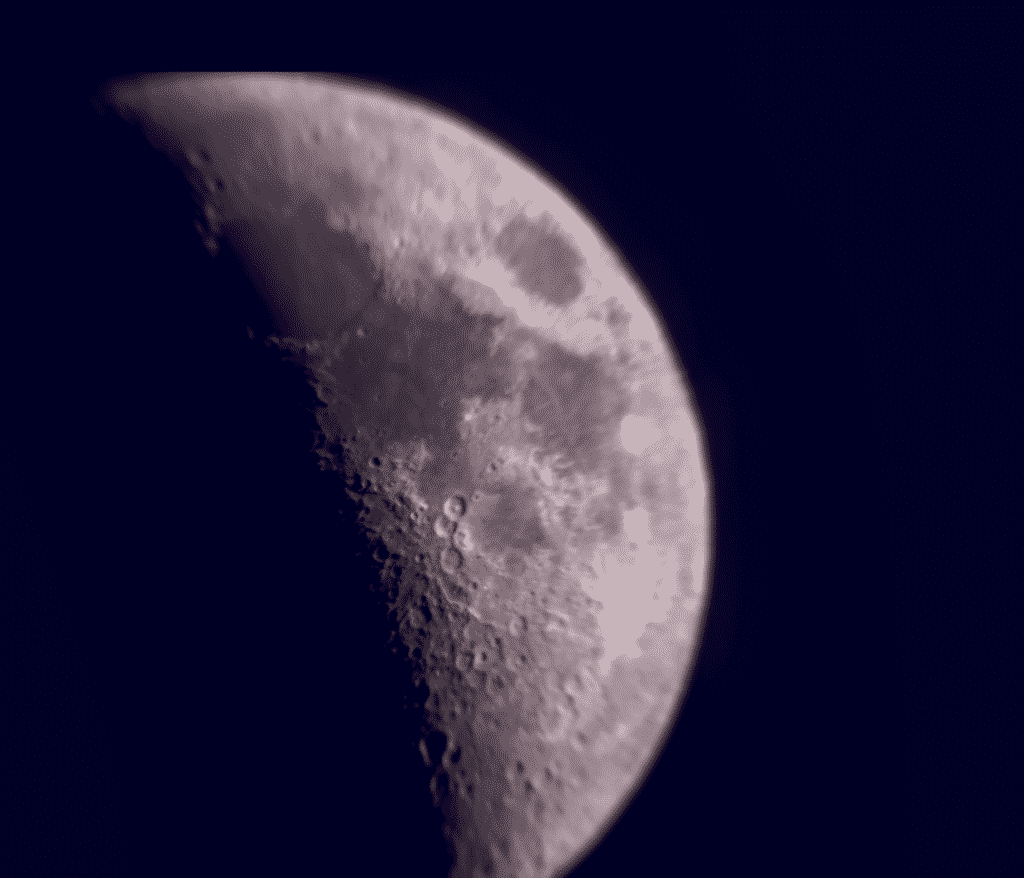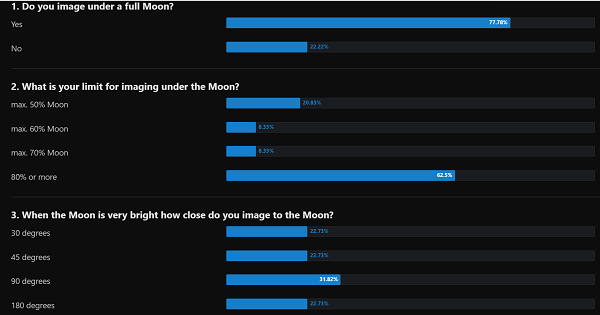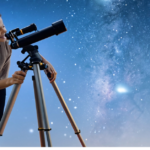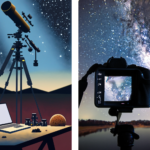The moon is perhaps the most noticeable feature that we can see in the night sky. For astrophotographers, the phase of the moon on any given night is extremely important. I know I am constantly checking on my phone app, Clear Outside, to find out what is the current phase of the moon and how it will change over the coming week or so.
The main reasons why I check the current phase of the moon and its rise and setting time are because it affects the brightness of the sky, and sometimes I may want to photograph our beautiful satellite. In this article, I will discuss how the moon affects astrophotography, but elsewhere on this website, I’ll explain more about how to photograph the moon.
What are the Different Phases of the Moon?
Here is a brief description of the lunar cycle and the different phases of the moon. This cycle lasts approximately 4 weeks and constantly repeats throughout the year.
- New Moon: This is the first phase of the lunar cycle, and it occurs when the moon is positioned between the sun and the earth, with its illuminated side facing away from the earth. During this phase, the moon is not visible in the sky.
- Waxing Crescent: As the moon orbits the earth and begins to move away from the sun, the portion of its illuminated side that is visible from the earth begins to increase, creating the appearance of a thin crescent shape. This phase is called the waxing crescent.
- First Quarter: When the moon is at a 90-degree angle to the sun and earth, with half of its illuminated side visible from the earth, it is in the first quarter phase.
- Waxing Gibbous: As the moon continues to orbit the earth and its illuminated side becomes more visible, it enters the waxing gibbous phase, in which more than half but less than all of its illuminated side is visible.
- Full Moon: When the moon is directly opposite the sun in its orbit, with its illuminated side fully facing the earth, it is in the full moon phase.
- Waning Gibbous: As the moon moves away from the full moon phase, the portion of its illuminated side that is visible from the earth begins to decrease, entering the waning gibbous phase.
- Third Quarter: When the moon is at a 90-degree angle to the sun and earth again, with half of its illuminated side visible from the earth, it is in the third quarter phase.
- Waning Crescent: As the moon continues to orbit the earth and its illuminated side becomes less visible, it enters the waning crescent phase, in which less than half of its illuminated side is visible.
After the waning phase, the lunar cycle begins again with the new moon phase.
What is the current phase of the moon?
The first way to determine what phase the moon is in right now is to look at it and try to estimate its phase. You obviously can’t tell if it is waning or waxing by just looking at it, but you can see approximately what percentage is illuminated. The other thing that changes with the current phase of the moon is the position in the sky where the moon is. This can affect what target you should choose with a bright moon.
If your moon is full, you may find it better to choose a target that is far away from the moon to reduce the effect of the glare. Remember that the light from the moon is no different from other forms of light pollution and will impact your images, especially if your astrophotography target is too close to the moon.



The second way to answer the question, “What is the current phase of the moon?” is to use a calculator or app. In order to help you out with this, here is a moon phase calculator that you can use to find out exactly how much of the moon is illuminated in the sky at any date you want.
You can also use the calculator to find out when the next new moon or full moon is, which can be very helpful in astrophotography as it is very challenging to image under a full moon and is best at the time of a new moon because that is when the sky is darkest and not illuminated by the moon’s light.
Moon Phase Calculator
What is the current phase of the moon? Let’s find out:
What Causes the Different Phases of the Moon?
There are many websites (including Nasa’s page about the Moon Phases) that talk about this in detail if you want a deeper explanation, but basically, here is my explanation.
The Moon orbits the Earth in under four weeks (27.32 days in fact). This means that the moon moves about 13 degrees along its path each day towards the east. I’ve observed while waiting for the Moon to decrease in brightness that it rises a little bit later each day, and this is because the Earth has to rotate a bit more to put the Moon in the same position as the night before.
As the Moon changes its position in relation to us on Earth, the sun shines on the surface of the Moon from a different angle, causing one part to be illuminated and one part of the face we see to be in shadow. When the Moon is directly facing the Sun from our perspective (i.e., the Moon and Earth are aligned), we see a full moon, but when the Moon is on the other side of the earth in a position 180 degrees from this, the side of the moon we see faces away from the Earth and is in complete darkness.
When the moon is in complete darkness, there is no light reflecting from it and, therefore, no skyglow to affect our astrophotos. The New Moon is the best time to image, as the sky is at its darkest level.
The Role of the Moon’s Phases in the Planning of Astrophotography Sessions
The moon phase is so important for astrophotography because of its brightness. When the moon phase is such that the illumination from reflected light coming from the sun begins to light up the sky, it impacts the contrast of any images you take. I have found that more than 60% illumination and less than about 45 degrees between the moon and my deep sky target are enough to negatively impact my astrophotos.
To begin planning your astrophotography session, you must answer this: what is the current phase of the moon?
It is possible to mitigate the effects of a bright moon using a narrowband filter rather than the normal RGB filters often used.
When doing landscape astrophotography you want the moon to have lower illillumination, the moon’s position and phase are crucial.
When the moon is very bright and the phase is above about 40 or 50 percent, I use my ZWO Duoband filter. This filter captures the two wavelengths of light found in the deep sky objects I normally image, nebulae. It can also be used to capture the hydrogen alpha in a galaxy such as M33, the Triangulum Galaxy.
The filter I use has a bandpass of 15 nm, which means that some light pollution and moonlight can pass through, which does mean that I have to be careful to image away from the moon and only image when the moon is less than a maximum of approximately 70%.
I would like to add a comment here that the exact percentage of the moon when you decide to go ahead and take photographs of the night sky depends on your experience and knowledge. Now, while using narrowband techniques and after having improved my processing techniques, I can easily image with even an 80% or more illuminated moon.
Other filters can cut out more light pollution and moonlight, such as the Optolong L-Extreme or L-Ultimate, which I believe has a bandpass of 3nm. This could make it possible to even image under a full moon, as long as you do not point your equipment too close to the moon.
In summary, the moon is a source of light pollution, scattering light that will increase the gradient and mask details in your astronomy photos. Wait until the phase of the moon is more suitable.
For astrophotography, another thing I’ve found helpful is understanding that the moon rises later each day by an average of about 50 minutes or so, which means that I have often been able to get a few hours of imaging in before the bright moon comes up. As long as the moon is below the horizon, it has not affected my imaging at all since I also make sure to image at least 30 degrees above the horizon.
Research Survey: How Do Astrophotographers Adapt To the Different Phases of the Moon?
I decided to conduct a survey and ask members of forums such as StargazersLounge about what they do when there is a bright moon and how this affects their astrophotography. Below are the results I got from three basic questions.

Results of the Survey
As expected, I found that many astrophotographers are not put off by a full or bright Moon. However, I was surprised at the percentages. My research showed that 77% of astrophotographers surveyed continue imaging under a full moon, and 22% do not. As confirmed by the comments I received from many respondents, under the full moon, imaging in narrowband is the best way to capture deep-sky objects.
In my second question, I tried to get respondents to be more specific about any limitations they had regarding when they would decide, if at all, that the moon was too bright for them to image. A large majority, (62.5%), said that they image when the moon is more than 80% illuminated. Almost 21% said that their limit was when the Moon was 50% illuminated.
Finally, I asked how close an angle to the bright Moon they generally image. One in three chose 90%, while the other answers were all equal in number.
One thing I did notice in the comments I received was that some of the respondents appeared confident enough in their ability to post-process images that they could image under a full Moon and go a bit closer to the Moon. Generally, of course, there is an admission that this processing is more difficult and not always ideal.
If you do find yourself wanting to photograph the moon you may ask yourself the question is tonight a full moon? Normally the full moon last for possibly two or three days. Probably best to plan for the different phases and I would recommend consulting a moon phase calendar or even buying one so you always know in advance how much illumination from the moon might affect your astrophotography.
Conclusion
It’s essential to know the answer to “What moon phase is it right now?” because of the effect it has on the brightness of the sky. The current phase of the moon can determine how and when we can image and capture astrophotos. Some astrophotographers prefer to avoid imaging during a full moon or around that time of the month, while others continue to image using narrowband filters and by imaging a certain distance away from the moon. It’s ultimately up to you to decide what is best for you. Good luck with your astrophotography!







